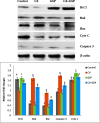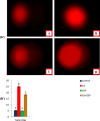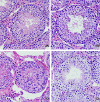The molecular and biochemical insight view of grape seed proanthocyanidins in ameliorating cadmium-induced testes-toxicity in rat model: implication of PI3K/Akt/Nrf-2 signaling
- PMID: 30355647
- PMCID: PMC6331675
- DOI: 10.1042/BSR20180515
The molecular and biochemical insight view of grape seed proanthocyanidins in ameliorating cadmium-induced testes-toxicity in rat model: implication of PI3K/Akt/Nrf-2 signaling
Expression of concern in
-
Expression of Concern: The molecular and biochemical insight view of grape seed proanthocyanidins in ameliorating Cadmium-induced Testes-toxicity in rat model: Implication of PI3K/Akt/Nrf-2signaling.Biosci Rep. 2020 Aug 28;40(8):BSR-20180515_EOC. doi: 10.1042/BSR-20180515_EOC. Biosci Rep. 2020. PMID: 32749471 Free PMC article. No abstract available.
Abstract
The present study aims to evaluate the protective effect of grape seed proanthocyanidins (GSP) on cadmium (Cd)-induced testicular apoptosis, inflammation, and oxidative stress in rats. A total of 24 male Wistar rats were divided into four groups, namely control, GSP (100 mg/kg BW), Cd (5 mg/kg BW), and Cd+GSP. Cd-treated rat testes exhibited a significant increment in oxidative stress mediated inflammation and apoptosis. Pre-administration of GSP exhibit significant protection against the apoptotic and inflammatory damages elicited by Cd and uphold the intercellular antioxidant status in testes. Histological changes were studied and the immunohistochemical staining for caspase 3, HSP70, and eNOS protein expressions were also analyzed to justify the protective action of GSP. Furthermore, GSP prevented DNA damage, and enhanced the expression of antioxidant responsive elements Nrf2/HO-1 by PI3K/Akt-dependent pathway. Therefore, our results suggest that GSP acts as a multipotent antioxidant entity against Cd-induced oxidative testicular toxicity in rats.
Keywords: Nrf2/HO-1; antioxidant; cadmium; grape seed proanthocyanidins; oxidative stress; testes.
© 2019 The Author(s).
Conflict of interest statement
The authors declare that there are no competing interests associated with the manuscript.
Figures











References
-
- Alsberg C.L. and Schwartze E.W. (1919) Pharmacological action of Cd. Pharmacology 13, 504–509
-
- Takiguchi M. and Yoshihara S. (2006) New aspects of cadmium as endocrine disruptor. Environ. Sci. 13, 107–116 - PubMed
Publication types
MeSH terms
Substances
LinkOut - more resources
Full Text Sources
Medical
Research Materials

